|
|
|
little Ethiopia
Monday, May 9 2011
location: Via del Governo Vecchio, Rome, Italy
Today's Roman sightseeing would be to the northeast of the neighborhood where we'd been staying, closer to Rome's main train terminal (the place where we began our pedestrian experience several days ago). On the way there, we went to a cafeteria type of place Gretchen had found out about. The food wasn't great and there wasn't much choice (particularly for a vegan), but it was cheap, and we got to eat it while crowded in with other working-class Italians. Most of them were in uniform, and Gretchen asked one in improvised Italian what he did for a living and he gruffly replied that he was military, and then started laughing with his comrades for reasons unknown.
Our first post-lunch destination was the site of the old Baths of Diocletian, a place that once featured enormous indoor dunking pools of various temperatures, heated massage areas, and an outdoor swimming pool a full acre in size. All of these had been provided to ancient Romans as a perk of citizenship (though a nominal door charge had been collected, presumably to keep the place from becoming unpleasantly overcrowded). In the days before electricity, water was the principle utility: for drinking, cleaning, bathing, and to carry away wastes. If all those things can be provided for, a lot more people can be crowded together in a small area. This was how Rome managed to become the world's first true metropolis. It celebrated its water with monumental aqueducts, elaborate well-distributed fountains, public baths, and vast sewage networks. The thing that finally did Rome in was the barbarian sabotage of its aqueducts, bringing the Dark Ages to Rome in an instant. They could have perhaps more accurately been termed the Stank Ages.
Now, of course, the Roman baths are just another Roman Catholic Church (as that appears to be the only disposition people can — or at least could — imagine for a large building). Part of the task of converting the ruins of the ancient Roman baths to a church was undertaken by Michelangelo, though modifications to his plan were made later. Now, once in the church, the only evidence that it was ever anything else is its vastness, and the oddity of the entrance being at the end of a transept, not the nave. There are also a few other odd details, like the presence of an elaborate solar clock involving a hole high on a wall and a long graduated linear scale inlain into the marble floor. There's so much space within the church that some of it had been given over to two different art shows. Back at the far-end of one of the non-door transept, there were a pair of large plaster angels dating to the 19th Century that had been covered (in all their lower parts that could be reached) with hasty graffiti (most in pen, pencil, or shallow scratches). At least one graffito dated to 1916.
After our fill of the church built ontop of a place where sodomy was presumably common, we went around it on its east side, and up Viale de Nicola, a street lined with vendors and a grassy strip where homeless people were sleeping their way through the lunch hour. We actually wanted to just lie in the grass ourselves, but finding grass of any sort in Rome is difficult, especially when it doesn't come in long narrow strips adjacent to busy streets. After consulting our maps and some walking around to the north and west, we came upon a pleasant park no bigger than 1000 square feet. It was centered around a fountain and included a number of evergreen trees. We lay on the grass (it was much spottier than park grass ever is allowed to get in America) under a tree and watched a Hooded Crow bring various food items to wash in the fountain before eating. This activity excited both the fountain's resident goldfish and a number of European Blackbirds, both of which came over to feed on leftover scraps.
As we were leaving the park, we discovered it had been behind a gate that is normally accessible only with a key; we'd managed to get there when the gate just happened to be open and lucked into someone's private park.
Church tour continued in this part of town, though the churches weren't quite as spectacular as they'd been in our neighborhood. There was, however, a very odd display in the basement of one church: several rooms decorated with designs made from the bones of dead Capuchin monks. You're told at the door not to take photographs, but I (like the Wikipedia contributor) managed to snap a few pictures. It's a clever repurposing of human remains, and an almost intuitive use for so many nearly-identical copies of so many types of certain shapes. Personally I'd have no problem with someone using my skeleton for such purposes once I'm finished using it.
From there we walked northwestward through a neighborhood that, with its palm trees and glassy non-ancient buildings, rather reminded me of San Vincente Blvd. in Santa Monica. This was the neighborhood of the American Embassy, and it lacks all the character of the neighborhood of the apartment we were renting to the southwest. There are no cobblestones, and it takes some doing to find a café with outdoor seating. Indeed, there are no such cafés in this neighborhood, one has to go eastward, where the grid (though impersonal and cobblestone-free) has a more mixed-use character. Eventually we settled down at some place with outdoor seating where huge 20 ounce Peronis could be had for something like three euros. That's a good way to unwind from hours of the museum shuffle (that slow, sleep-inducing walk one does when sightseeing on foot).
Though there's little charm to this part of Rome, it seems to be home to the city's Ethiopian shopping district. There is an Ethiopian grocery store (selling injera), a place selling Ethiopian music (among other non-consumables), and at least two Ethiopian restaurants. Asmara, the one we were looking for, was closed, so we ended up at Africa, the other (which was technically Eritrean). The vegetarian plate for two was surprisingly good, though the service definitely left something to be desired. I had mine with another enormous 20 ounce Peroni.
Before walking home, Gretchen bought several sheets of injera from the Ethiopian grocery, though the woman working the store didn't really know how to price it, and broken Italian was the only common language, at least until the boss showed up.
Back at our cozy apartment, the pirated WiFi we'd been using for the past several days (thanks, alechiarollaAT-SIGNtiscali.it!) seemed to be dead. The other day I'd had some trouble with it but had been able to log into the WiFi router's configuration page and reboot it, restoring it to service. This time, though, I couldn't get a good enough connection. In the end, Gretchen had to go down the street a few blocks to find another person's open WiFi router so she could check her email.
So we ended up watching terrible roadtrip movie called Due Date. It was an extremely conventional Zach Galifianakis vehicle, with him sleepwalking his way through a reprise of his character in The Hangover, playing a guy who is both irritatingly odd and stupid. Last night we'd watched Step Brothers, which is also weak comedic gruel, but by comparison it now seemed like comedic gold.
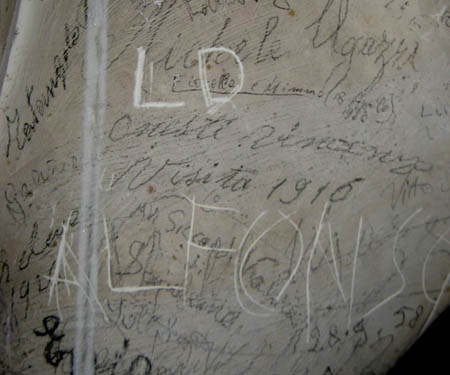
Graffiti on a plaster angel at the church on the site of the Baths of Diocletian.

A structure near the Baths of Diocletian.
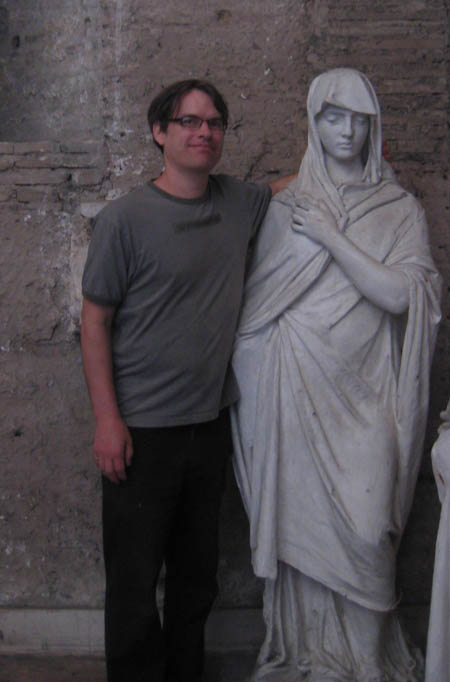
Me with my marble bride in the church built atop the Baths of Diocletian.
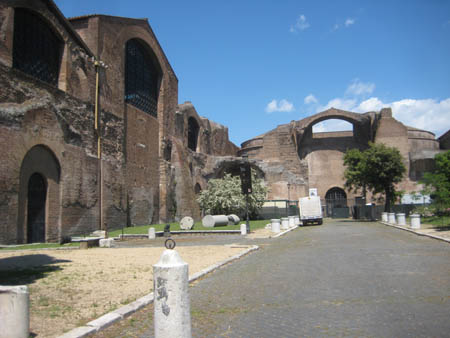
More ruins near the Baths.
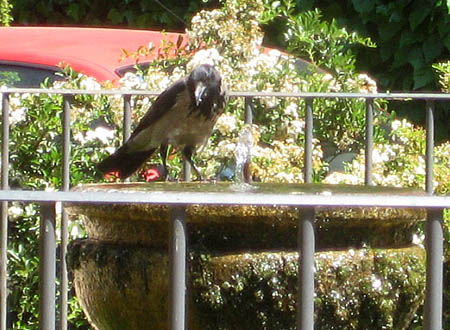
The Hooded Crow washing his or her meal in the fountain at a private Roman park.
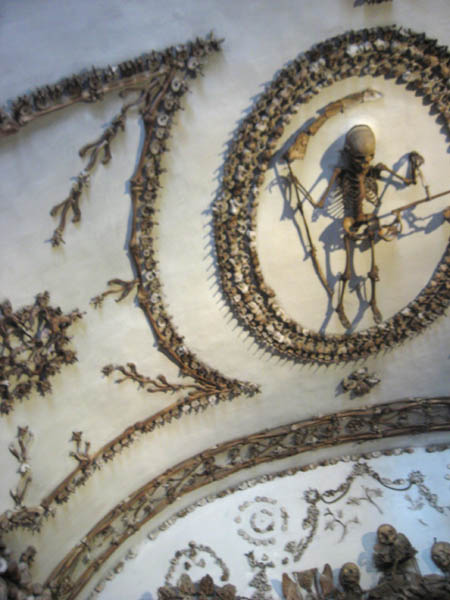
Designs at the Capuchin Crypt made from human bones.

The church above the Capuchin Crypt look neglected; all its surfaces are covered with sooty grime like those of an abandoned attic.
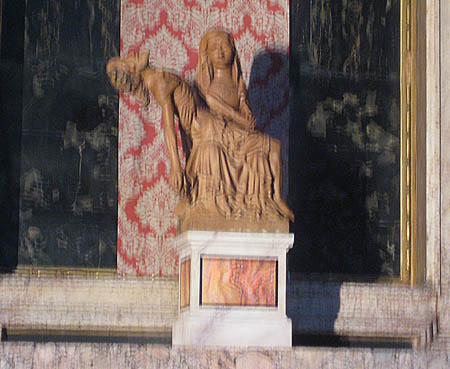
An amusing Pietà by someone other than Michelangelo.
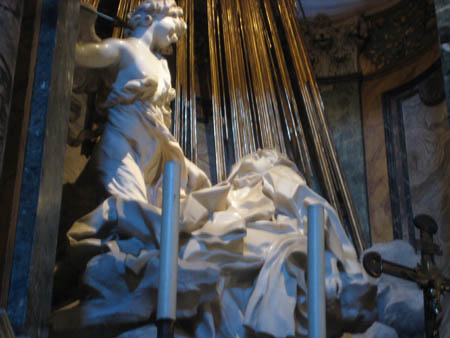
Gretchen had told me about a Bernini statue of Theresa in ecstasy, a baroque classic. And here it was. She's not quite as orgiastic as Gretchen had led me to believe she would be.

Me and my first large Peroni of the evening.
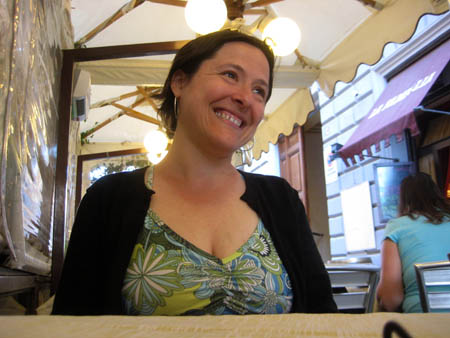
Gretchen at the large Peroni place.
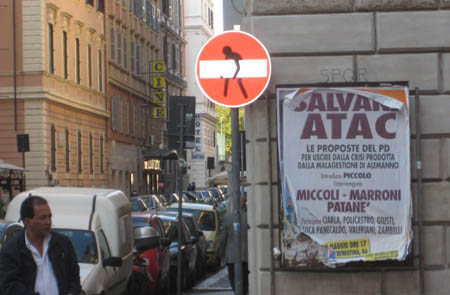
Someone has been altering signs in Rome to give them bigger narratives. Here a figure carries the do not enter bar, which looks to weigh 50 pounds or so.
For linking purposes this article's URL is:
http://asecular.com/blog.php?110509 feedback
previous | next |











